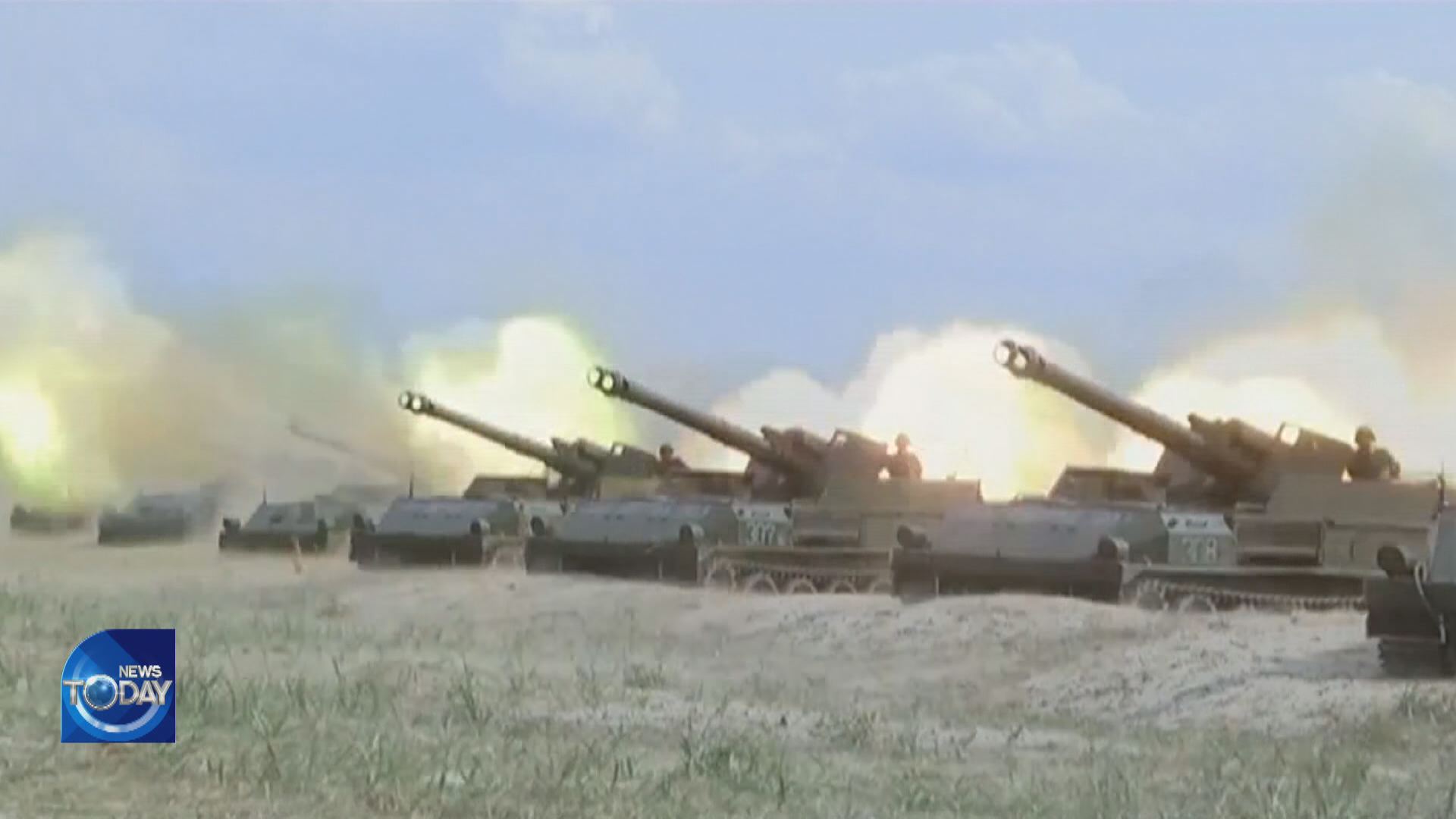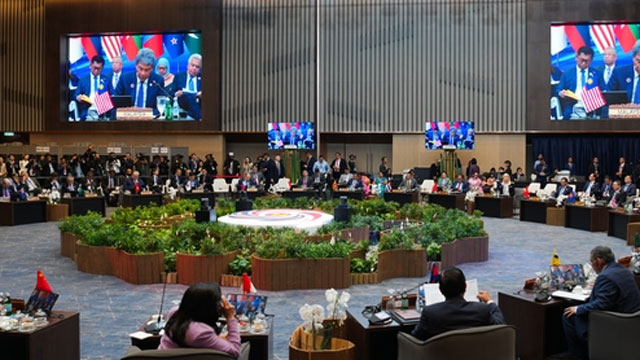N. KOREA CONTINUES PROVOCATIONS
입력 2022.10.14 (15:06)
수정 2022.10.14 (16:45)
읽어주기 기능은 크롬기반의
브라우저에서만 사용하실 수 있습니다.
[Anchor Lead]
North Korea deployed about ten combat aircraft overnight in an ostensible demonstration of their military might and even went ahead with multiple simultaneous provocations of firing artillery rounds and launching a ballistic missile.
[Pkg]
The Joint Chiefs of Staff announced traces of flight by about ten North Korean combat aircraft between 10:30 p.m Thursday and 12:20 a.m. Friday were identified. The planes flew south of the tactical action line and came within five kilometers of the no-fly zone in the western inland area before turning back. They also flew about seven kilometers north of the no-fly zone in the western inland region and 12 kilometers north of the Northern Limit Line in the West Sea. The South Korean Air Force scrambled F-35As to respond proportionally to the movements of North Korea's military aircraft while maintaining readiness. The regime followed its aerial provocation with another launch of a ballistic missile. The JCS reported that around 1:50 a.m. Friday North Korea fired a short-range ballistic missile from the Sunan area of Pyongyang toward the East Sea. The missile flew for about 700 kilometers at an altitude of around 50 kilometers at Mach 6. The JCS also said that before the missile launch, North Korea fired some 130 artillery rounds toward the West Sea from the Majang-dong area of Hwanghaedo- Province for around five minutes at 1:20 a.m. After the missile launch, another 40 rounds of artillery fire toward the East Sea were detected at the Gueup-ri region in northern Gangwon-do Province for some ten minutes around 2:57 a.m. The JCS reported the shells fell in the buffer zones north of the NLL in the East and West Sea delineated in the 2018 inter-Korean military pact. Apparently, no shells fell in South Korean territorial waters. Artillery fires in the buffer zones clearly violate the 2018 military accord and the launch of a ballistic missile went against the UNSC resolution. Seoul and Washington's military authorities are monitoring the movements of North Korean forces to brace for additional provocations.
North Korea deployed about ten combat aircraft overnight in an ostensible demonstration of their military might and even went ahead with multiple simultaneous provocations of firing artillery rounds and launching a ballistic missile.
[Pkg]
The Joint Chiefs of Staff announced traces of flight by about ten North Korean combat aircraft between 10:30 p.m Thursday and 12:20 a.m. Friday were identified. The planes flew south of the tactical action line and came within five kilometers of the no-fly zone in the western inland area before turning back. They also flew about seven kilometers north of the no-fly zone in the western inland region and 12 kilometers north of the Northern Limit Line in the West Sea. The South Korean Air Force scrambled F-35As to respond proportionally to the movements of North Korea's military aircraft while maintaining readiness. The regime followed its aerial provocation with another launch of a ballistic missile. The JCS reported that around 1:50 a.m. Friday North Korea fired a short-range ballistic missile from the Sunan area of Pyongyang toward the East Sea. The missile flew for about 700 kilometers at an altitude of around 50 kilometers at Mach 6. The JCS also said that before the missile launch, North Korea fired some 130 artillery rounds toward the West Sea from the Majang-dong area of Hwanghaedo- Province for around five minutes at 1:20 a.m. After the missile launch, another 40 rounds of artillery fire toward the East Sea were detected at the Gueup-ri region in northern Gangwon-do Province for some ten minutes around 2:57 a.m. The JCS reported the shells fell in the buffer zones north of the NLL in the East and West Sea delineated in the 2018 inter-Korean military pact. Apparently, no shells fell in South Korean territorial waters. Artillery fires in the buffer zones clearly violate the 2018 military accord and the launch of a ballistic missile went against the UNSC resolution. Seoul and Washington's military authorities are monitoring the movements of North Korean forces to brace for additional provocations.
■ 제보하기
▷ 카카오톡 : 'KBS제보' 검색, 채널 추가
▷ 전화 : 02-781-1234, 4444
▷ 이메일 : kbs1234@kbs.co.kr
▷ 유튜브, 네이버, 카카오에서도 KBS뉴스를 구독해주세요!
- N. KOREA CONTINUES PROVOCATIONS
-
- 입력 2022-10-14 15:06:12
- 수정2022-10-14 16:45:02

[Anchor Lead]
North Korea deployed about ten combat aircraft overnight in an ostensible demonstration of their military might and even went ahead with multiple simultaneous provocations of firing artillery rounds and launching a ballistic missile.
[Pkg]
The Joint Chiefs of Staff announced traces of flight by about ten North Korean combat aircraft between 10:30 p.m Thursday and 12:20 a.m. Friday were identified. The planes flew south of the tactical action line and came within five kilometers of the no-fly zone in the western inland area before turning back. They also flew about seven kilometers north of the no-fly zone in the western inland region and 12 kilometers north of the Northern Limit Line in the West Sea. The South Korean Air Force scrambled F-35As to respond proportionally to the movements of North Korea's military aircraft while maintaining readiness. The regime followed its aerial provocation with another launch of a ballistic missile. The JCS reported that around 1:50 a.m. Friday North Korea fired a short-range ballistic missile from the Sunan area of Pyongyang toward the East Sea. The missile flew for about 700 kilometers at an altitude of around 50 kilometers at Mach 6. The JCS also said that before the missile launch, North Korea fired some 130 artillery rounds toward the West Sea from the Majang-dong area of Hwanghaedo- Province for around five minutes at 1:20 a.m. After the missile launch, another 40 rounds of artillery fire toward the East Sea were detected at the Gueup-ri region in northern Gangwon-do Province for some ten minutes around 2:57 a.m. The JCS reported the shells fell in the buffer zones north of the NLL in the East and West Sea delineated in the 2018 inter-Korean military pact. Apparently, no shells fell in South Korean territorial waters. Artillery fires in the buffer zones clearly violate the 2018 military accord and the launch of a ballistic missile went against the UNSC resolution. Seoul and Washington's military authorities are monitoring the movements of North Korean forces to brace for additional provocations.
North Korea deployed about ten combat aircraft overnight in an ostensible demonstration of their military might and even went ahead with multiple simultaneous provocations of firing artillery rounds and launching a ballistic missile.
[Pkg]
The Joint Chiefs of Staff announced traces of flight by about ten North Korean combat aircraft between 10:30 p.m Thursday and 12:20 a.m. Friday were identified. The planes flew south of the tactical action line and came within five kilometers of the no-fly zone in the western inland area before turning back. They also flew about seven kilometers north of the no-fly zone in the western inland region and 12 kilometers north of the Northern Limit Line in the West Sea. The South Korean Air Force scrambled F-35As to respond proportionally to the movements of North Korea's military aircraft while maintaining readiness. The regime followed its aerial provocation with another launch of a ballistic missile. The JCS reported that around 1:50 a.m. Friday North Korea fired a short-range ballistic missile from the Sunan area of Pyongyang toward the East Sea. The missile flew for about 700 kilometers at an altitude of around 50 kilometers at Mach 6. The JCS also said that before the missile launch, North Korea fired some 130 artillery rounds toward the West Sea from the Majang-dong area of Hwanghaedo- Province for around five minutes at 1:20 a.m. After the missile launch, another 40 rounds of artillery fire toward the East Sea were detected at the Gueup-ri region in northern Gangwon-do Province for some ten minutes around 2:57 a.m. The JCS reported the shells fell in the buffer zones north of the NLL in the East and West Sea delineated in the 2018 inter-Korean military pact. Apparently, no shells fell in South Korean territorial waters. Artillery fires in the buffer zones clearly violate the 2018 military accord and the launch of a ballistic missile went against the UNSC resolution. Seoul and Washington's military authorities are monitoring the movements of North Korean forces to brace for additional provocations.
이 기사가 좋으셨다면
-
좋아요
0
-
응원해요
0
-
후속 원해요
0










![[HEADLINE]](https://news.kbs.co.kr/data/news/title_image/newsmp4/news_today/2022/10/14/10_5578705.jpeg)






이 기사에 대한 의견을 남겨주세요.